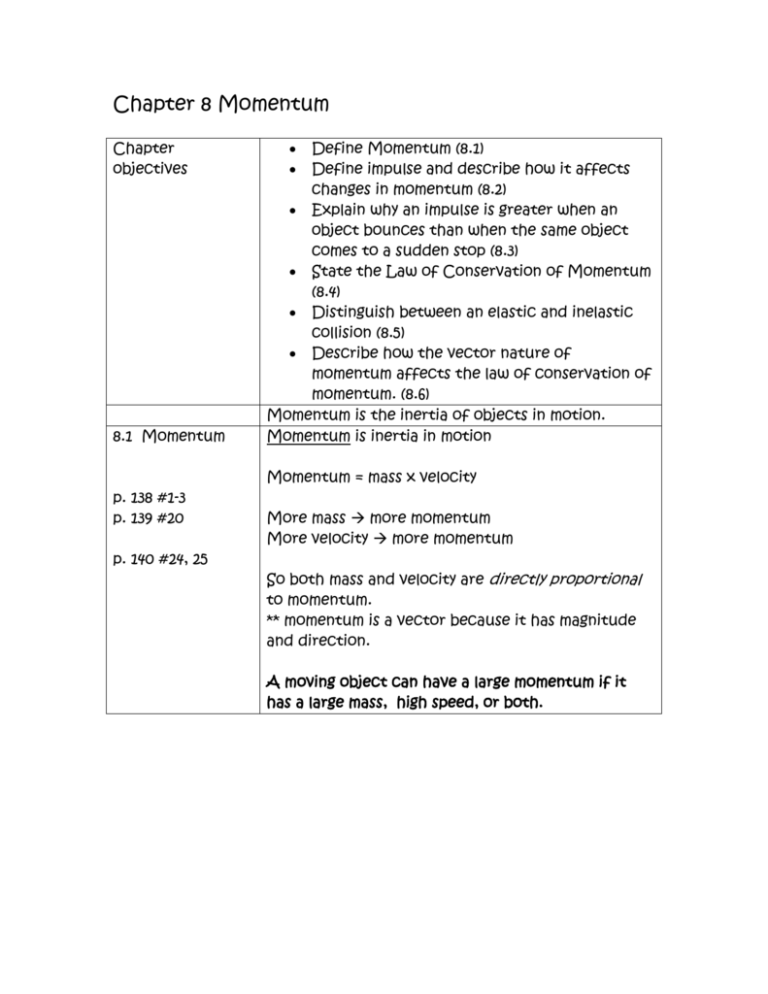Chapter 8 Momentum Chapter objectives Define Momentum (8.1
advertisement

Chapter 8 Momentum Chapter objectives 8.1 Momentum p. 138 #1-3 p. 139 #20 p. 140 #24, 25 Define Momentum (8.1) Define impulse and describe how it affects changes in momentum (8.2) Explain why an impulse is greater when an object bounces than when the same object comes to a sudden stop (8.3) State the Law of Conservation of Momentum (8.4) Distinguish between an elastic and inelastic collision (8.5) Describe how the vector nature of momentum affects the law of conservation of momentum. (8.6) Momentum is the inertia of objects in motion. Momentum is inertia in motion Momentum = mass x velocity More mass more momentum More velocity more momentum So both mass and velocity are directly proportional to momentum. ** momentum is a vector because it has magnitude and direction. A moving object can have a large momentum if it has a large mass, high speed, or both. 8.2 Impulse changes Momentum p. 138 #4-11 p. 139 #21 Impulse is a change in momentum For momentum to change there must be a change in velocity or a change in mass. For there to be a change in velocity (this is called acceleration) there must be a force. The larger the force, the greater the change. Not only is the size of the force important, but how long the force acts on the object is considered. Impulse = force x change in time Or Impulse = Fxt Or Ft= (mv) A batter in baseball swings through the ball to apply force for the longest period of time. Same as a golfer swinging through. The change in momentum depends on the force tha acts and the length of time it acts. Egg in the sheet demo When decreasing impulse, the longer the time of impact the smaller the force. If Then impulse = Fxt F = impulse t so the longer the time of impact, the less force. We can see from this equation that time of the impact is inversely proportional to Force Think about this in terms of cushioned athletic shoes. The padding increases the time of impact so force is decreased. See bungee jumping on p. 128 consider Ali’s “rope-a-dope” move These barrels are filled with increasingly heavy sand to gradually slow a car speeding toward the barricade. Since the impact will be spread out, there will be less force. A ceramic dish falling on a tile floor is more likely to break than the same dish falling on a wooden floor. When we jump down, it is safer to bend the knees. 8.3 Bouncing Have students catch a bowling ball. Have them catch the ball then throw it back. Which requires more force? p. 138 #12-14 p. 141 #47 In a bungee jump, the cord stretches twice the length of the cord to absorb the force. “Impulses are greater when an object bounces.” P. 91 Stopping an object takes a certain amount of force. But stopping the object and then throwing it back again takes more force. Imagine catching a ball in your hand. Imagine catching it and throwing it back. Which involves more impulse? The impulse required to bring an object to a stop and the to “throw it back again” is greater than the impulse required merely to bring the object to a stop. 8.4 Conservation of momentum p. 138 #15,16 Changing momentum requires an external force. Momentum within a system is conserved. The Law of Conservation of Momentum states: In the absence of an external force the momentum of a system remains unchanged. Consider a cannon and cannonball system. Before firing the system has a momentum of zero. After firing, the cannon and cannonball each have the same momentum but in opposite directions. So the net is zero 8.5 Collisions see diagram with the colliding balls on p. 132 The law of conservation of momentum states that, in the absence of an external force, the momentum of a system remains unchanged. There are two types of collisions: Elastic & Inelastic When objects collide without being permanently deformed and without generating heat, it is said to be an elastic collision. Momentum is transferred from one object to another. i = F see diagram of the train cars on p. 133 p. 139 # 17,18 p. 140 #26,27,32 net momentum before = net momentum after represents momentum i is “initial” momentum F is “final” momentum Whenever colliding objects get tangled or coupled together, there is an inelastic collision. Whenever objects collide in the absence of external forces the net momentum of both objects before the collision equals the net momentum of both objects after the collision. ???? Why is p used for momentum? m is used for mass, so P is used for the persistence of the object. 8.6 Momentum Vectors Collisions that occur at angles can be analyzed by using vectors that we used earlier. p. 139 #19 The vector sum of the momenta is the same before and after a collision.








